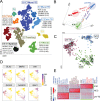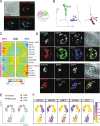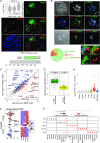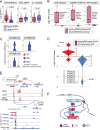A new human embryonic cell type associated with activity of young transposable elements allows definition of the inner cell mass
- PMID: 37339119
- PMCID: PMC10281584
- DOI: 10.1371/journal.pbio.3002162
A new human embryonic cell type associated with activity of young transposable elements allows definition of the inner cell mass
Abstract
There remains much that we do not understand about the earliest stages of human development. On a gross level, there is evidence for apoptosis, but the nature of the affected cell types is unknown. Perhaps most importantly, the inner cell mass (ICM), from which the foetus is derived and hence of interest in reproductive health and regenerative medicine, has proven hard to define. Here, we provide a multi-method analysis of the early human embryo to resolve these issues. Single-cell analysis (on multiple independent datasets), supported by embryo visualisation, uncovers a common previously uncharacterised class of cells lacking commitment markers that segregates after embryonic gene activation (EGA) and shortly after undergo apoptosis. The discovery of this cell type allows us to clearly define their viable ontogenetic sisters, these being the cells of the ICM. While ICM is characterised by the activity of an Old non-transposing endogenous retrovirus (HERVH) that acts to suppress Young transposable elements, the new cell type, by contrast, expresses transpositionally competent Young elements and DNA-damage response genes. As the Young elements are RetroElements and the cells are excluded from the developmental process, we dub these REject cells. With these and ICM being characterised by differential mobile element activities, the human embryo may be a "selection arena" in which one group of cells selectively die, while other less damaged cells persist.
Copyright: © 2023 Singh et al. This is an open access article distributed under the terms of the Creative Commons Attribution License, which permits unrestricted use, distribution, and reproduction in any medium, provided the original author and source are credited.
Conflict of interest statement
The authors have declared that no competing interests exist.
Figures




Comment in
-
The human embryo selection arena is associated with transposable element activity.PLoS Biol. 2023 Jun 20;21(6):e3002153. doi: 10.1371/journal.pbio.3002153. eCollection 2023 Jun. PLoS Biol. 2023. PMID: 37348048 Free PMC article.
Similar articles
-
The human embryo selection arena is associated with transposable element activity.PLoS Biol. 2023 Jun 20;21(6):e3002153. doi: 10.1371/journal.pbio.3002153. eCollection 2023 Jun. PLoS Biol. 2023. PMID: 37348048 Free PMC article.
-
Does mouse embryo primordial germ cell activation start before implantation as suggested by single-cell transcriptomics dynamics?Mol Hum Reprod. 2016 Mar;22(3):208-25. doi: 10.1093/molehr/gav072. Epub 2016 Jan 5. Mol Hum Reprod. 2016. PMID: 26740066
-
Effects of assisted reproductive technologies on transposon regulation in the mouse pre-implanted embryo.Hum Reprod. 2019 Apr 1;34(4):612-622. doi: 10.1093/humrep/dez020. Hum Reprod. 2019. PMID: 30865273
-
The post-inner cell mass intermediate: implications for stem cell biology and assisted reproductive technology.Hum Reprod Update. 2015 Sep-Oct;21(5):616-26. doi: 10.1093/humupd/dmv028. Epub 2015 Jun 18. Hum Reprod Update. 2015. PMID: 26089403 Review.
-
[Mechanics of inner cell mass formation].Biol Aujourdhui. 2017;211(2):137-148. doi: 10.1051/jbio/2017021. Epub 2017 Dec 13. Biol Aujourdhui. 2017. PMID: 29236662 Review. French.
Cited by
-
Staring at the onco-exaptation: the two-faced medley of an ancient retrovirus, HERVH.J Clin Invest. 2023 Jul 17;133(14):e172278. doi: 10.1172/JCI172278. J Clin Invest. 2023. PMID: 37463444 Free PMC article.
-
The human embryo selection arena is associated with transposable element activity.PLoS Biol. 2023 Jun 20;21(6):e3002153. doi: 10.1371/journal.pbio.3002153. eCollection 2023 Jun. PLoS Biol. 2023. PMID: 37348048 Free PMC article.
-
Transposable elements may enhance antiviral resistance in HIV-1 elite controllers.bioRxiv [Preprint]. 2023 Dec 12:2023.12.11.571123. doi: 10.1101/2023.12.11.571123. bioRxiv. 2023. PMID: 38168352 Free PMC article. Preprint.
-
Deconstructing genomic plasticity in the early human embryo: transposable elements having their way!J Assist Reprod Genet. 2024 Sep;41(9):2225-2226. doi: 10.1007/s10815-024-03247-x. J Assist Reprod Genet. 2024. PMID: 39225841 No abstract available.
-
Deregulation of oxidative phosphorylation pathways in embryos derived in vitro from prepubertal and pubertal heifers based on whole-transcriptome sequencing.BMC Genomics. 2024 Jun 24;25(1):632. doi: 10.1186/s12864-024-10532-7. BMC Genomics. 2024. PMID: 38914933 Free PMC article.
References
-
- Meistermann D, Bruneau A, Loubersac S, Reignier A, Firmin J, Francois-Campion V, et al.. Integrated pseudotime analysis of human pre-implantation embryo single-cell transcriptomes reveals the dynamics of lineage specification. Cell Stem Cell. 2021;28(9):1625–40 e6. Epub 2021/05/19. doi: 10.1016/j.stem.2021.04.027 . - DOI - PubMed
-
- Radley A, Corujo-Simon E, Nichols J, Smith A, Dunn SJ. Entropy sorting of single-cell RNA sequencing data reveals the inner cell mass in the human pre-implantation embryo. Stem Cell Reports. 2023;18(1):47–63. Epub 20221013. doi: 10.1016/j.stemcr.2022.09.007 ; PubMed Central PMCID: PMC9859930. - DOI - PMC - PubMed
Publication types
MeSH terms
Substances
Grants and funding
LinkOut - more resources
Full Text Sources
Research Materials

